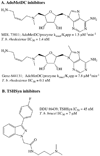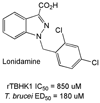State of the art in African trypanosome drug discovery
- PMID: 21401507
- PMCID: PMC3101707
- DOI: 10.2174/156802611795429167
State of the art in African trypanosome drug discovery
Abstract
African sleeping sickness is endemic in sub-Saharan Africa where the WHO estimates that 60 million people are at risk for the disease. Human African trypanosomiasis (HAT) is 100% fatal if untreated and the current drug therapies have significant limitations due to toxicity and difficult treatment regimes. No new chemical agents have been approved since eflornithine in 1990. The pentamidine analog DB289, which was in late stage clinical trials for the treatment of early stage HAT recently failed due to toxicity issues. A new protocol for the treatment of late-stage T. brucei gambiense that uses combination nifurtomox/eflornithine (NECT) was recently shown to have better safety and efficacy than eflornithine alone, while being easier to administer. This breakthrough represents the only new therapy for HAT since the approval of eflornithine. A number of research programs are on going to exploit the unusual biochemical pathways in the parasite to identify new targets for target based drug discovery programs. HTS efforts are also underway to discover new chemical entities through whole organism screening approaches. A number of inhibitors with anti-trypanosomal activity have been identified by both approaches, but none of the programs are yet at the stage of identifying a preclinical candidate. This dire situation underscores the need for continued effort to identify new chemical agents for the treatment of HAT.
Figures













References
-
- Kennedy PG. The continuing problem of human African trypanosomiasis (sleeping sickness) Ann Neurol. 2008;64(2):116–126. - PubMed
Publication types
MeSH terms
Substances
Grants and funding
LinkOut - more resources
Full Text Sources

